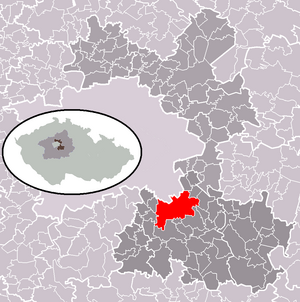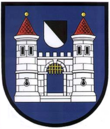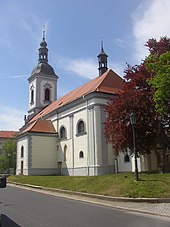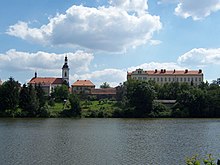Říčany
| Říčany | ||||
|---|---|---|---|---|
|
||||
| Basic data | ||||
| State : |
|
|||
| Region : | Středočeský kraj | |||
| District : | Praha-východ | |||
| Area : | 2580 ha | |||
| Geographic location : | 49 ° 59 ' N , 14 ° 39' E | |||
| Height: | 341 m nm | |||
| Residents : | 15,619 (Jan 1, 2019) | |||
| Postal code : | 251 01 | |||
| traffic | ||||
| Railway connection: | České Velenice – Prague | |||
| structure | ||||
| Status: | city | |||
| Districts: | 8th | |||
| administration | ||||
| Mayor : | Vladimír Kořen (as of 2010) | |||
| Address: | Masarykovo náměstí 53 251 01 Říčany |
|||
| Municipality number: | 538728 | |||
| Website : | www.ricany.cz | |||
| Location of Říčany in the Praha-východ district | ||||

|
||||
Říčany (German Ritschan ) is a town with 15,619 (January 1, 2019) inhabitants in the Středočeský kraj region in the Czech Republic .
location
Říčany is located on the southeastern border of the capital Prague on Říčanský potok, on the course of which the ponds Marvánek and Mlýnský rybník were created in the city. The railway line from Prague to Benešov also runs through Říčany . The train station is in the city center. The Rokytka flows through the Radošovice district .
history
The oldest settlement already took place in the time of the Celts . In addition to their ceramics, iron smelting furnaces from Roman times and tombs of the first Slavs were also found. Říčany was also the last stop on the Salt Route from Hallstadt to Prague. The second trade route through the place led to Moravia, Poland and Hungary. During the Christianization of Bohemia, the first deanery was established in the place.
In the 13th century, Ottokar II gave Přemysl Říčany to the Lords of Všechrom, a noble family who held high offices in the kingdom and of which especially Peter (1260) and Andreas were mentioned in writing. Around 1270, Andreas, treasurer of the Kingdom of Bohemia, built a castle and a forecourt nearby. The ruins of the castle still remind of the Gothic buildings. Frescoes from this period can still be found in the church of St. Peter and Paul.
The Hussite Wars ended the boom in the settlement . At the time when all three Hussite units united and there was also agreement among themselves, they besieged the castle in 1420. It was agreed between the besiegers and the besieged to open the gates of the castle and to give the inmates safe passage. Some wings of the Hussites , especially the Taborites , did not keep this bargain. They stormed the castle, started the pillage and arrested some priests and castle inmates.
After the Hussite Wars, the owners changed in quick succession. First the place belonged to the capital Prague, then the Lords Popel von Vestec, since 1486 Trčka von Lípa , under whom the village again experienced an economic boom. In 1551 Ostrov von Kralowitz bought the lands and in 1572 Smiřický von Smiřice . Jaroslav Smiřický moved his seat to the newly built castle in Aurinowes after seven years , but obtained confirmation of the town charter, a new coat of arms and seal from Emperor Maximilian II. In 1575. After the class uprising in Bohemia (1618) the city was confiscated and the castle abandoned.
During the Thirty Years War , the city was completely destroyed, and a number of villages in the area were completely destroyed. But as early as the second half of the 17th century, the residents elected a new city council, appointed a captain and set up an administration with twelve aldermen.
In the course of the replacement of patrimonial in Bohemia, Říčan became the seat of a district court in 1849 . In 1850 the city was assigned to the new political district owl . In 1869, Říčany was connected to the railway network and thus became the economic center of the region. The good transport links and proximity to the capital led to the rapid settlement of trade and crafts. Prague citizens built luxury villas and summer residences in the place. From 1869 the town belonged to the Bohemian Brod District and from 1898 to the Žižkov District .
The Oliveum has also been part of the city since 1896. It was founded by the Olivov couple as an educational institution for "morally threatened" children. During the Second World War it served as a rest home, then as a sanatorium for tuberculosis. Today it is a sanatorium for childhood respiratory diseases.
In preparation for the incorporation of the city of Žižkov into Prague, the seat of the district administration Žižkov was moved to Říčany in 1921. In 1925 the district was renamed Okres Říčany / District Bezirkíčan. On June 1, 1942 Říčany lost its status as a district town; the districts Eule and Ritschan were combined to form the new district Prague-Land-Süd / Okres Praha-venkov-jih with headquarters in Prague. After the end of the Second World War, the Okres Říčany was rebuilt on November 27, 1945. During the territorial reform of 1960 the Okres Říčany was repealed and the city was assigned to the Okres Praha-východ .
Local division
The town of Říčany consists of the districts Jažlovice, Krabošice, Kuří, Pacov, Radošovice, Říčany, Strašín and Voděrádky.
Administrative area
The city is the administrative authority for 52 municipalities, including three cities.
School system
There are three elementary schools and two grammar schools in the city, the state grammar school Říčany and a private Masarykovo klasické gymnázium.
Personalities
sons and daughters of the town
- Andreas von Dauba (Ondřeje z Dubé) (1320–1412), Supreme Judge of the Kingdom of Bohemia, settled at the Zlenice Castle (Hláska u Senohrab).
- Diwisch von Rican (Diviš ze Říčan), the envoy of Emperor Sigismund asked in 1415 not to allow the removal of the escort of Jan Hus . He himself was not a supporter of the preacher.
- Rudolf Horowetz (* 1865), President of the General Pension Fund and Minister of Economics of the Czechoslovak Republic, Head of the Office for External Economic Relations and first Chairman of the Oriental Institute
- Gustav Trnka (* 1888), historian
- Jan Tichý (* 1890), entomologist, after whom the beetle Pristonychus Tichyi cult was named
- Ferdinand Vach (1860–1939), founder of the Moravian Teachers Choral Society
- Aneta Langerová (* 1986) singer
Lived and worked in the city
- Karel Havlíček Borovský was the envoy of the city and region to the Kremsier Assembly
- Antonín Švehla , the host from Hostivař, was also elected envoy of the region.
Attractions
- Ruins of the Říčany castle, west of Masarykovo náměstí
- Church of St. Peter and Paul on Masarykovo náměstí
- Marian columns on Masarykovo náměstí
Partner communities
Říčany has been partnered with the city of Borken in North Rhine-Westphalia since 2017 .
Web links
Individual evidence
- ↑ Český statistický úřad - The population of the Czech municipalities as of January 1, 2019 (PDF; 7.4 MiB)
- ↑ 185/1942 Sb.
- ↑ Decree č. 121/1945 Sb.
- ↑ "On July 12th, 2017 the city council of Borken unanimously decided on the town partnership with the Czech city of Řičany." Retrieved March 12, 2019, 7:28 pm





